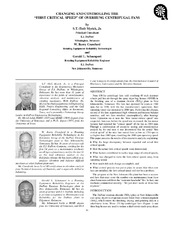| dc.description.abstract | Nine 150 hp centrifugal fans with overhung 40 inch diameter wheels pull hot air through the spray dryer bag houses (SDBH) in the finishing area of a titanium dioxide (TiO2) plant in New Johnsonville, Tennessee. The fans had operated for years at 900 rpm, but in 1998, with the fan manufacturer’s agreement, their operating speed was increased to 2080 rpm. Following this change, several of the fans experienced high vibration and became balance sensitive, and two fans wrecked catastrophically after bearings failed. Operation on or near the “first lateral critical speed” was suspected; however, before the speed was increased, the fan manufacturer had reported the “critical speed” of the fan as 3000 rpm. Through a combination of extensive testing and rotordynamics analysis by the end user, it was determined that the actual “first critical speed” of the nine fans varied from as low as 1700 rpm to no higher than 2405 rpm, straddling the 2080 rpm operating speed. This paper presents the results of the extensive analysis, explaining: *Why the large discrepancy between reported and actual first critical speeds, * How the actual first critical speeds were determined, *What factors contributed to such a large range of critical speeds, *What was changed to move the first critical speeds away from operating speed, *How much did each change accomplish, and *What control process was put in place to assure that when new fans are installed, the first critical speed will not be a problem. The program at the New Johnsonville plant has been a success and fans that once were the number one maintenance issue have since been removed from the “constant headache” list. In fact, one mechanic commented recently: “We just don’t work on those fans anymore.” | en |


